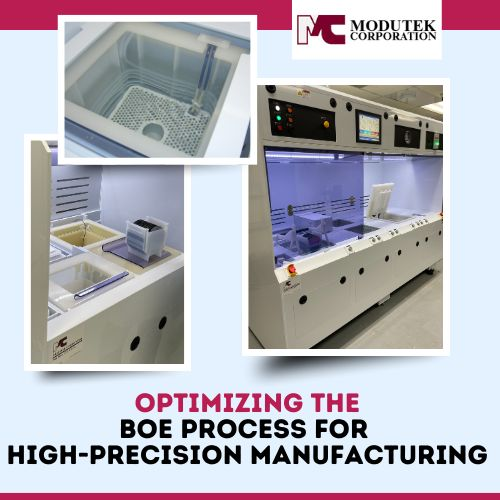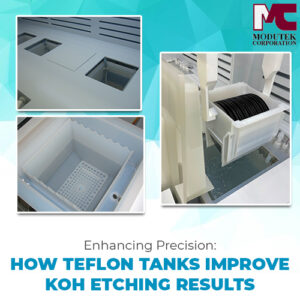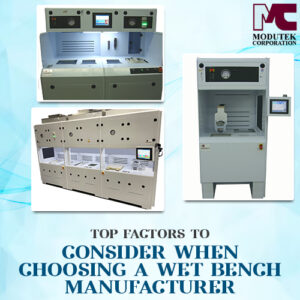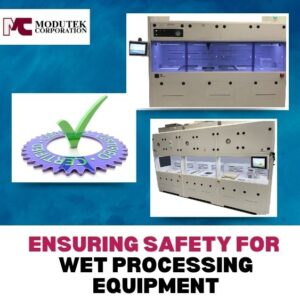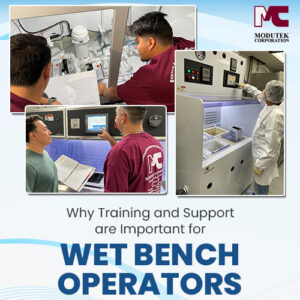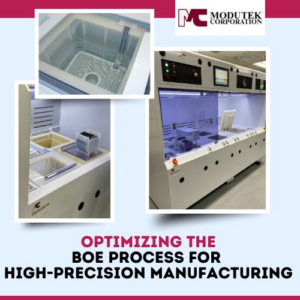 In the constantly evolving field of semiconductor manufacturing, achieving high-precision results is paramount. Buffered Oxide Etch (BOE) plays a crucial role in this process, providing the precise etching capabilities required for intricate semiconductor devices. This article guides process engineers in optimizing the BOE process for small-scale wet processing tabletop baths to large-scale wet bench systems. Understanding and controlling the variables that affect BOE processes will lead to enhanced precision, ensure repeatability, and maintain clean and safe operations.
In the constantly evolving field of semiconductor manufacturing, achieving high-precision results is paramount. Buffered Oxide Etch (BOE) plays a crucial role in this process, providing the precise etching capabilities required for intricate semiconductor devices. This article guides process engineers in optimizing the BOE process for small-scale wet processing tabletop baths to large-scale wet bench systems. Understanding and controlling the variables that affect BOE processes will lead to enhanced precision, ensure repeatability, and maintain clean and safe operations.
Understanding Buffered Oxide Etch (BOE)
Buffered Oxide Etch (BOE) is a mixture of HF and a buffering agent such as ammonium fluoride (NH4F), which allows the etching of silicon dioxide layers on wafers to be more controlled than the etching of pure HF solution. BOE is used in semiconductor fabrication because it enables the etching reactions to take place at a more constant rate. As a result, BOE makes it easier to achieve the consistency in etching rates needed for high-precision manufacturing.
Key Benefits of Using BOE in High-Precision Manufacturing
- Better control and precision: BOE’s buffered solution allows for a slower and more controlled etching rate that is beneficial for applications where precise control of material removal is required. The control over etch rate helps remove the material only up to the desired depth so that underlying layers are not damaged.
- Uniform Etching: Because the buffering agent provides a constant etch rate, material can be removed at the same rate across the surface of the wafer. This uniformity across the surface of the wafer is necessary to maintain the stability of the complicated patterns and structures produced in semiconductor devices.
- Compatibility with Various Materials: BOE is compatible with a wide variety of materials used in semiconductor manufacture, including different types of silicon dioxide and other kinds of oxide, and this versatility allows it to be applied to a wide variety of etching techniques in both laboratory and manufacturing environments.
- Reduced Defects and Contamination: BOE allows for a higher level of control, which means fewer defects and contamination during a photoresist (or other substrate) etch. This results in lower rejects and a corresponding increase in yield, which is suitable for cost.
Leveraging these benefits, process engineers can optimize etching processes to achieve higher precision and repeatability, which is needed in advanced semiconductor manufacturing.
Variables Affecting the BOE Process
Optimizing the Buffered Oxide Etch (BOE) process requires a thorough understanding of the factors influencing its effectiveness and precision. Key variables such as temperature control, etchant concentration, and etching time are significant in achieving consistent and repeatable results in high-precision manufacturing. By carefully managing these variables, process engineers can enhance the performance of both small-scale and large-scale etching systems.
Temperature Control
Precise temperature control is essential to maintain a stable etch rate and ensure uniformity across the wafer. Temperature variations can lead to inconsistent etching, resulting in defects or uneven surfaces. Modutek’s advanced temperature control systems, such as the RCe series temperature control circulators and sub-ambient baths, provide the accuracy needed to maintain optimal temperatures throughout the etching process. This precision helps achieve the desired etch depth and uniformity, critical for high-precision manufacturing.
Etchant Concentration
The concentration of the etchant mixture directly impacts the etch rate and the quality of the etching process. A higher hydrofluoric acid (HF) concentration can increase the etch rate but may also lead to aggressive etching and potentially damage delicate structures. Conversely, a lower concentration provides more control but may require longer etching times. Finding the right balance is critical to optimizing the BOE process. Engineers should regularly monitor and adjust the concentration to suit different manufacturing scales and specific requirements of the wafer etching process.
Etching Time
Etching time is another critical variable that affects the outcome of the BOE process. An etching time that is too short may result in incomplete etching, while too long can lead to over-etching and damage to the substrate. Establishing precise guidelines for timing control helps ensure consistent and repeatable results. Engineers need to develop standard operating procedures (SOPs) that define the optimal etching time based on the specific characteristics of the processed wafers and the desired results.
By understanding and controlling these variables, process engineers can significantly improve the efficiency and precision of the BOE process. The ability to fine-tune temperature, concentration, and timing enables the production of high-quality wafers with minimal defects, enhancing overall manufacturing outcomes.
Optimizing BOE on Wet Processing Tabletop Baths
Optimizing the Buffered Oxide Etch (BOE) process on small-scale wet processing tabletop baths involves precise setup and diligent monitoring to ensure high precision and repeatability. These systems, often used in research and low-volume production, are ideal for experimenting with process variables. Here are key strategies for optimizing BOE in tabletop baths.
Setup and Optimization
- Equipment Calibration: Ensure all equipment, including temperature control units and flow meters, is accurately calibrated to maintain precise etching conditions.
- Solution Preparation: Prepare the BOE solution consistently, using high-purity chemicals to minimize contamination risks. Consistent preparation helps maintain stable etch rates.
- Process Parameters: Define and document process parameters such as temperature, concentration, and etching time. Initial trials and adjustments help establish a reliable baseline.
Troubleshooting Common Issues
- Non-Uniform Etching: Ensure uniform temperature control, consistent flow rates, and regular stirring of the BOE solution to prevent uneven etching.
- Surface Contamination: Implement strict cleanliness protocols and use cleanroom practices to minimize particle contamination.
- Variations in Etch Rate: Monitor and adjust temperature and concentration to maintain consistent etch rates. Ensure the BOE solution is fresh and uncontaminated.
Maintenance and Safety
- Regular Maintenance: Conduct routine checks on all equipment, replacing worn parts and cleaning components in contact with the BOE solution.
- Safety Protocols: Implement stringent safety measures, including proper PPE, emergency wash stations, and staff training for handling chemicals safely.
Process engineers can achieve high precision and reliability by meticulously setting up and optimizing the BOE process on tabletop baths. This foundation supports practical experimentation and process development, paving the way for scaling up to larger systems.
Scaling Up: Optimizing BOE on Wet Bench Systems
Transitioning the Buffered Oxide Etch (BOE) process from small-scale baths to large-scale wet bench systems introduces unique challenges. High-throughput environments require advanced techniques for maintaining precision and efficiency. Here’s how to optimize BOE for large-scale wet bench systems.
Challenges of Scaling the BOE Process
Scaling up requires uniform etch rates across larger areas and managing higher etchant volumes. These challenges necessitate robust process control mechanisms and advanced equipment.
Advanced Techniques for Managing Large-Scale Systems
- Enhanced Temperature Control: Utilize advanced temperature control systems like Modutek’s RCe series temperature control circulators and sub-ambient baths. These systems provide the precise temperature regulation required for uniform etching across larger surfaces.
- Automated Process Monitoring: In real-time, automated monitoring is used to track etchant concentration, temperature, and etching time. These systems detect deviations promptly, enabling quick adjustments to maintain optimal conditions.
- Consistent Flow Management: Ensure a consistent flow of the BOE solution across the wet bench. Advanced fluid dynamics designs and precise flow control mechanisms prevent localized variations in etch rates.
Maintenance and Safety Tips
- Regular System Checks: Perform routine maintenance to ensure all components function correctly. This includes inspecting temperature control units, flow meters, and etchant delivery systems. Regular checks minimize downtime and provide consistent performance.
- Safety Protocols: Enforce stringent safety protocols due to the larger volumes of hazardous chemicals. Provide comprehensive training for personnel and ensure emergency wash stations and protective gear are accessible.
- Preventive Measures: Use high-purity chemicals, maintain cleanroom conditions, and replace worn-out components to avoid contamination and equipment failure.
By addressing these challenges and implementing advanced techniques, process engineers can optimize the BOE process for high-throughput wet bench systems, ensuring precision, efficiency, and safety.
Ensuring Chemical Compatibility and Cleanliness
Maintaining chemical compatibility and cleanliness in the Buffered Oxide Etch (BOE) process is crucial for preventing contamination and achieving high-precision results. These factors play a significant role in ensuring the quality and reliability of semiconductor manufacturing.
Chemical Compatibility
- Material Selection: Use materials in wet bench stations that are chemically compatible with BOE solutions. Common materials include high-density polyethylene (HDPE), polypropylene (PP), and fluoropolymers like PTFE. These materials resist degradation and contamination to support the integrity of the etching process.
- Equipment Design: Design equipment to minimize chemical reactions with BOE solutions. This includes selecting appropriate seals, gaskets, and tubing that withstand exposure to hydrofluoric acid and other etching chemicals.
- Supplier Verification: Verify that suppliers provide materials and components that meet chemical compatibility standards. Working with reputable suppliers ensures that equipment performs reliably under BOE conditions.
Maintaining Cleanliness
- Cleanroom Protocols: Implement stringent cleanroom protocols to reduce particle contamination—regularly clean workspaces, tools, and equipment to maintain a contaminant-free environment. Use filtered air systems and wear appropriate cleanroom attire to minimize contamination risks.
- Regular Cleaning: Schedule regular cleaning and maintenance of wet bench systems to remove residues and prevent buildup. This includes thorough rinsing and drying of components after each use.
- Contamination Control: Use high-purity chemicals and DI (deionized) water for all processes. Contaminants in chemicals can compromise the etching process, leading to defects and reduced yield.
- Real-Time Monitoring: Implement real-time monitoring systems to detect contamination levels during etching processes. Promptly addressing contamination issues helps maintain high-quality outputs.
By ensuring chemical compatibility and maintaining cleanliness, process engineers can optimize the BOE process, reducing defects and enhancing the quality of semiconductor wafers. These practices are essential for achieving the precision required in high-tech manufacturing environments.
Achieving Precise Process Control of BOE Etching
Precise process control is essential in Buffered Oxide Etch (BOE) etching to ensure consistent, high-quality results in semiconductor manufacturing. Effective control over variables such as temperature, concentration, and etching time directly impacts the precision and reliability of the etching process.
Temperature Control
- Advanced Temperature Systems: Utilize Modutek’s RCe series temperature control circulators and sub-ambient baths. These systems offer precise temperature regulation, which is critical for maintaining consistent etch rates and uniformity across the wafer.
- Real-Time Monitoring: Implement real-time temperature monitoring to detect and adjust fluctuations immediately. This helps maintain the desired temperature throughout the etching process, ensuring repeatable results.
Concentration Control
- Automated Mixing Systems: Use automated systems to accurately mix and maintain the BOE solution concentration. These systems ensure the correct ratio of hydrofluoric acid and buffering agent, which is crucial for consistent etching performance.
- Regular Testing: Regularly test the etchant concentration to ensure it remains within optimal parameters. Adjustments should be made based on test results to maintain the desired etching conditions.
Etching Time Management
- Precision Timing Equipment: Employ precision timing equipment to control the duration of the etching process. Accurate timing ensures that the wafers are etched to the exact specifications required.
- Standard Operating Procedures (SOPs): Develop and follow SOPs that define the optimal etching times for different wafer types and desired outcomes. Consistent adherence to these procedures ensures repeatable and high-quality results.
Impact on Manufacturing Outcomes
- Quality and Yield: Precise control over the BOE process enhances the quality of etched wafers, reducing defects and increasing yield. This leads to higher production efficiency and cost-effectiveness.
- Process Consistency: Consistent process control minimizes variations, ensuring that each batch of wafers meets the required specifications. This reliability is critical for maintaining high standards in semiconductor manufacturing.
Engineers can achieve the precision necessary for successful BOE etching by leveraging advanced control systems and rigorous process management.
Conclusion
Optimizing the Buffered Oxide Etch (BOE) process is crucial for achieving the highest level of precision in semiconductor manufacturing. Process engineers can achieve consistent, high-quality results by focusing on critical variables such as temperature, etchant concentration, and etching time and using advanced techniques for small-scale and large-scale systems. In addition, maintaining chemical compatibility, cleanliness, and precise process control further enhances etching processes. Decision-makers should consider the total cost of ownership, supplier expertise, and reliability when selecting equipment and partners. For tailored equipment solutions and guidance on optimizing your BOE process, contact Modutek for a free consultation.

